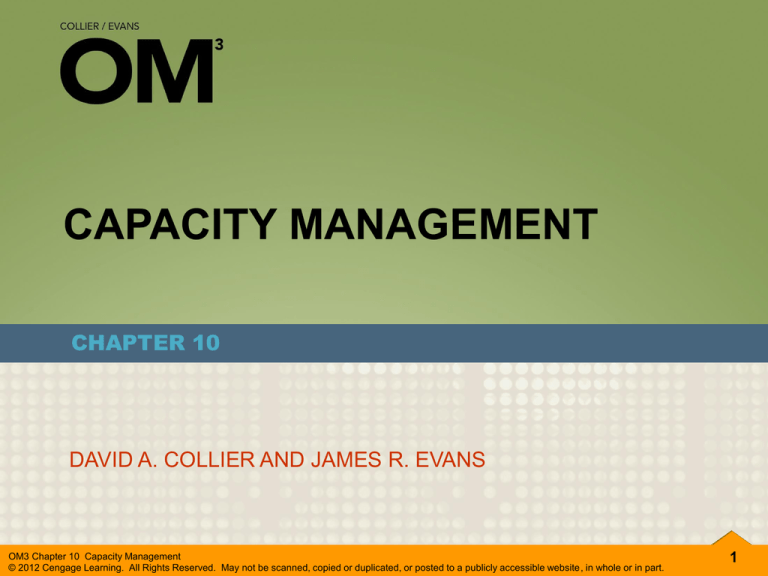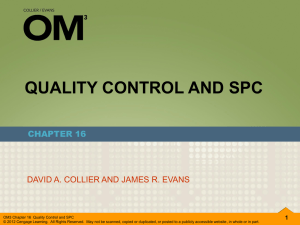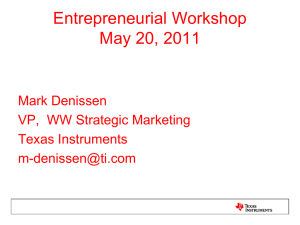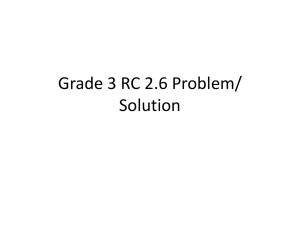
CAPACITY MANAGEMENT
CHAPTER 10
DAVID A. COLLIER AND JAMES R. EVANS
OM3 Chapter 10 Capacity Management
© 2012 Cengage Learning. All Rights Reserved. May not be scanned, copied or duplicated, or posted to a publicly accessible website, in whole or in part.
1
What do you think?
Have you ever
experienced problems
with a service because
of inadequate labor or
equipment capacity?
Understanding Capacity
• Capacity is the capability of a manufacturing
or service resource such as a facility, process,
workstation, or piece of equipment to
accomplish its purpose over a specified time
period.
Understanding Capacity
Capacity is determined by the resources available to
the organization—facilities, equipment, and labor—
how they are organized, and their efficiency as
determined by specific work methods.
Capacity can be viewed in one of two ways:
1. As the maximum rate of output per unit of time,
or
2. As units of resource availability.
Exhibit 10.1 Examples of Short- and Long-Term Capacity Decisions
Solved Problem
An automobile transmission-assembly factory
normally operates two shifts per day, five days per
week. During each shift, 400 transmissions can be
completed under ideal conditions. What is the
capacity of this factory?
Capacity = (2 shifts/day)(5 days/week) X
(400 tranmissions/shift) X
(4 weeks/month)
= 16,000 transmissions/month
Capacity Measurement in Operations
• Safety capacity (often called the capacity
cushion) is an amount of capacity reserved for
unanticipated events, such as demand surges,
materials shortages, and equipment breakdowns.
Average safety capacity (%)
= 100% − Average resource utilization % [10.1]
Capacity Measurement in Job Shops
• In a job shop, setup time can be a substantial
part of total system capacity.
Capacity Required (Ci) = Setup Time (Si)
+ [Processing Time (Pi)
x Order Size (Qi)]
= Si + [(Pi)(Qi )]
[10.2]
Solved Problem
Exhibit 10.3 Dental Office Procedures and Times for Today
Solved Problem
Exhibit 10.4 Dental Office Demand-Capacity Analysis
*Example computation:
C = (Si + Pi × Qi) = 15 + 15 + (90 × 2) = 210 minutes, assuming
a setup for each patient.
Solved Problem
• A total of 610 minutes of work are scheduled during a
480-minute workday.
• Capacity shortage of 130 minutes.
• 21.3% of capacity used to set up and change over
dental procedures.
• If setup times could be reduced by 50%, the capacity
shortage would be only 65 minutes, requiring only
one hour of overtime.
Short-Term Capacity Management
Adjust Short-Term Capacity Levels
•
•
•
•
•
Add or share equipment: Lease equipment as needed or set up
a partnership arrangement with capacity sharing. (Examples:
Mainframe computers, CAT scanner, farm equipment)
Sell unused capacity: Sell idle capacity to outside buyers and
even competitors. (Examples: Computing capacity, perishable
hotel rooms)
Change labor capacity and schedules: Short-term changes in
work force levels. (Examples: Overtime, extra shifts, temporary
employees, outsourcing)
Change labor skill mix: Hire the right people; cross-training.
Shift work to slack periods (Example: Build up inventory during
slack times and hold for peak demand times)
Short-Term Capacity Management
Shift and Stimulate Demand
•
Vary the price of goods or services (Examples: Cheaper hotel rates on
weekends; sales of overstocks)
•
Provide customers with information (Example: Automated messages with
best times to call or visit)
•
Advertising and promotion (Examples: After-holiday sales, manufacturer or
service coupons)
•
Add peripheral goods and/or services (Examples: Movie theater rentals at
off-peak times, extended service hours)
•
Provide reservations: A promise to provide a good or service at some future
time and place. (Examples: Hotels, airlines, surgeries)
Short Term Capacity Management
Revenue Management Systems
• A revenue management system (RMS) consists
of dynamic methods to forecast demand, allocate
perishable assets across market segments, decide
when to overbook and by how much, and determine
what price to charge different customer (price)
classes.
•
Examples: Managing overbooking in airlines, hotels,
and cruise lines (yield management).
Theory of Constraints
The Theory of Constraints (TOC) is a set of
principles that focuses on increasing total process
throughput by maximizing the utilization of all
bottleneck work activities and workstations.
• Throughput: Amount of money generated per
time period through actual sales.
• Constraint: Anything that limits an organization
from moving toward or achieving its goal.
Theory of Constraints
• A physical constraint is associated with the
capacity of a resource (e.g., machine, employee).
• A bottleneck work activity is one that
effectively limits capacity of the entire process.
• A nonbottleneck work activity is one in which
idle capacity exists.
• A nonphysical constraint is environmental or
organizational (e.g., low product demand or an
inefficient management policy or procedure).
Chapter 10
Solved Problems
17
Solved Problem
An automobile transmission-assembly factory
normally operates two shifts per day, five days per
week. During each shift, 400 transmissions can be
completed under ideal conditions. What is the
capacity of this factory?
18
Solved Problem
An automobile transmission-assembly factory
normally operates two shifts per day, five days per
week. During each shift, 400 transmissions can be
completed under ideal conditions. What is the
capacity of this factory?
Capacity = (2 shifts/day)(5 days/week) X
(400 tranmissions/shift) X
(4 weeks/month)
= 16,000 transmissions/month
19
Solved Problem
Exhibit 10.3 Dental Office Procedures and Times for Today
20
Capacity Required (Ci) = Setup Time (Si) + [Processing Time (Pi) x Order Size (Qi)
[10.2]
Solved Problem
Exhibit 10.4 Dental Office Demand-Capacity Analysis
*Example computation:
C = (Si + Pi × Qi) = 15 + 15 + (90 × 2) = 210 minutes, assuming
a setup for each patient.
21
Solved Problem
• A total of 610 minutes of work are scheduled during a
480-minute workday.
• Capacity shortage of 130 minutes.
• 21.3% of capacity used to set up and change over
dental procedures.
• If setup times could be reduced by 50%, the capacity
shortage would be only 65 minutes, requiring only
one hour of overtime.
22
Chapter 10
Solved Problems
Fast Burger Example
23
24
25
26


![[2]主、谓语的确定](http://s2.studylib.net/store/data/005326597_1-06d5f2d27312948cdde4df7bcfc1ed4c-300x300.png)









